Questions and Answers
This Questions and Answers section is a compilations of general questions from Warmaster Journal issues 2024, 2025 and other sources as noted.
Small edits within the main rules to incorporate these clarifications are shown like this.
General questions
Why aren’t more units from Warhammer / Warhammer Total War in the army lists?
Warmaster Revolution seeks to preserve the original game designed by Rick Priestly as far as possible. This means the Warmaster army lists are based around units that were available in 6th edition Warhammer, as these were the options available at the time. The army lists are intended to reflect the playstyle of the army as a whole, rather than representing each individual unit variation. Units represent hundreds of troops from the most common troop types associated with the army. You can use alternative models to represent elite versions of units by granting a magic item to an existing unit type. For example, give a magic sword to a High Elf Spearmen unit to represent High Elf Swordmasters.
→ Rulebook: Introducing Warmaster.
How are different types of units based?
Infantry is based facing the long edge (40mm) of the stand. All other unit types – Cavalry, Chariots, Monsters, Artillery and Machines – are based facing the short edge (20mm).
There are some exceptions to this rule which are clearly listed in the unit special rules for their army list. For example, Pikemen are Infantry that face the short edge of their base. Harpies and Daemon Flyers are Monsters that face the long edge of their base.
→ Rulebook: Game Values – Stands.
On what base size do I mount Warmaster characters?
Characters may be mounted on either a standard rectangular base of 40mm × 20mm, or a circular base up to 25mm in diameter. In either case, command range is then measured from the edge of the character base.
Alternatively, you may mount characters on larger base sizes, for example to make a diorama. If you do so, you must measure distances from one specific point on their base which is clear to your opponent.
How large should terrain features be? How many pieces should be used?
Terrain features like woods, villages, fields and lakes are typically around 15–30cm across.
Tournament organisers usually use 12–15 terrain features on a battlefield:
-
3 woods
-
3 hills or slopes
-
3 areas of broken or marshy ground
-
3 low, linear walls
-
1–3 other features
→ Rulebook: Battlefields – Setting up scenery.
When do stands count as In the Open?
All stands are considered to be In the Open, unless they are Defended or Fortified. Only Infantry and Artillery can ever claim Defended or Fortified status, when in suitable terrain.
This is worked out on a stand-by-stand basis. A unit may have some stands In the Open and some that are Defended, for example.
Stands of Cavalry, Chariots, Monsters, and Machines, count as being In the Open regardless of the terrain they occupy.
When a unit is In the Open, attacks will hit them on a 4+ and normal charge bonus attacks apply.
In addition, Infantry which is Charging, Pursuing, Retreating or Advancing can never claim Defended status, regardless of terrain or spell effects.
The only exceptions to this rule are the following:
-
The Empire Steam Tank
-
The Kislev War Wagon in laager formation.
These units always count as Defended, even though they are machines, and regardless of terrain.
This means the enemy will hit them on a 5+ and enemy chargers gain no Charge bonus attacks against them.
-
Cannon shots ignore the target’s Defended status, so will hit Defended stands on 4+.
-
Undead Ethereal Hosts always hit the target in combat on a 4+, but still get no charge bonus against Defended targets.
-
Stands in Loose Terrain are In the Open, but attackers gain no charge bonus against them.
Line of sight questions
Do units require Line of Sight at the beginning of their turn in order to charge?
No. Units require Line of Sight to charge at the beginning of their move, not that start of the turn. So it is entirely possible for one unit that is blocking Line of Sight to move out of the way, granting Line of Sight to another unit before it moves.
→ Rulebook: Command – Sequence of movement (Figure 1, Figure 2).
Can stands draw Line of Sight at 180 degrees from their front corners?
No. In order to draw Line of Sight, the target must be in front of the line that extends 180 degrees from the front corners of a stand. If in doubt place the straight edge of a suitably sized piece of paper against the front of the unit claiming Line of Sight. The paper represents the Line of Sight zone. If the target unit’s base occupies any part of the paper, you can draw Line of Sight.
Units wishing to shoot at chargers that connect with their flank cannot do so unless any stand from the charging unit is forward of the 180 degree line at any point before, during or after the charge move.
Remember, the Line of Sight is blocked by the presence of other stands, friendly or enemy. This prevents missile units in column drawing line of sight sideways out of the column.
The only exceptions are units that have 360 degree line of sight.
→ Rulebook: Game Values – Line of sight (Figure 3).
When Shooting, can a unit draw Line of Sight through gaps of less than 1 cm?
No. To draw Line of Sight when shooting, a unit must have at least 1cm width unobstructed on the edge from which it is rdawing line of sight, and be able to extend this unobstructed 1cm width in a straight line to the target.
→ Rulebook: Shooting – Targets.
How do Hills block Line of Sight?
Hills block Line of Sight beyond their highest elevation point. Line of Sight is blocked by a hill terrain piece that lies completely between two stands which are not on the hill. Units may draw Line of Sight to other units on a Hill provided the Line of Sight does not go beyond the highest elevation point. If line of sight is drawn to or from a stand positioned on a hill, only parts of the hill that are higher than both stands block line of sight between them.
→ Rulebook: Game Values – The effect of terrain, Movement – Terrain.
Command questions
Can one player’s characters issue orders to enemy units?
No! Each player’s characters can only issue orders to friendly units in that player’s command phase.
→ Rulebook: Command & Initiative – Giving an order.
Does the +1 for the next command, for being on a road, carry over to the next turn?
No. Roads provide a +1 Command bonus to the next order received by a unit that turn, provided the unit began and ended its ordered movement in column formation on the road, and no stand left the road as it moved.
→ Rulebook: Movement – Types of terrain – Roads and tracks.
Movement questions
When stands in a unit pivot to turn 180 degrees, how much movement does this cost?
Pivoting a unit’s stands can occur as part of a unit’s directional move, or stands in a unit can make a 180 degree pivot on the spot. To work out how much movement this takes up, follow these rules:
Pivot 180 degrees during a move
Measure the distance travelled by the corner moving the furthest distance. This will be from the corner of the stand diagonally opposite to the stand’s final position, as shown in diagrams below.
→ Rulebook: Movement – The move.
Pivot on the spot
Stands can pivot on the spot without physically rotating in a circle. Imagine the troops performing an about face manoeuvre on their own base, with the front rank swapping places with the back rank. The movement distance involved is the distance travelled by one corner to the opposite corner, which is 4½cm for a standard Warmaster base. This does not cause the pivoting stand to intersect with other stands in the same unit. Note that this means that Artillery stands are permitted to about face on the spot with a failed order and a half pace move of 5cm. See diagram below.
→ Rulebook: Movement – The move.
How does the displacement of a character that is touched by an enemy unit work?
A character piece that is not already joined to a friendly unit may move to join a friendly unit within 30cm when an enemy unit touches their base. Move the character when the first enemy stand contacts the character base. The character must be able to trace a path to a friendly unit around impassable terrain and enemy units, unless they have a flying mount, in which case they can move over them. However, the displaced character is permitted to pass through the stands of the enemy unit that touches them. This prevents characters from being unfairly surrounded and killed by mobile enemy units such as flyers.
Once the character has been displaced, the enemy unit may continue its move if possible. Remember that a flying unit that is moved via an order to displace a character has landed, so cannot continue moving without an additional order.
How does Maximising Frontage work, including when charging more than one enemy?
Charging stands must place as much of the front edge of the base as possible in contact with the enemy when they form a battle line. This also extends to any enemy units in line with the original target of the charge. So if a charging stand can only fit half of its frontage in contact with the original target of the charge, but can fit all of its frontage in contact with a stand from the original target and a stand from another enemy unit in line, it must do this. However if the charging unit can fit all of the frontage of all of its stands against the target unit, without touching any adjacent enemy stands, it will do this.
Forming a battle line
Each stand must be placed in the battle line in such a way that as much of its front edge as possible makes contact with the enemy. This is called ‘maximising frontage’. If it is impossible to place a stand into the battle line so that its front edge makes contact with an enemy, then it must be placed so that its front corner touches an enemy if it can. This means that the maximum number of charging stands will be drawn into the combat.
The diagrams below show how a charging unit will maximise frontage against an enemy that has a different base orientation to them. All charging stands can be placed with all of their frontage in contact with the enemy, so they must do this.
In this Diagram, the charging unit has not maximised frontage. This charge is illegal.
Contact with other enemy
If there are other enemy units adjacent to the target unit then the obligation to ‘maximise frontage’ extends to these other units too. So, where there is another enemy stand aligned to the target unit, a charging stand must be placed against this second enemy if this is its only way to maximise frontage. However, chargers will always maximise frontage against the unit they originally charged where they can do so.
The diagrams below show how a charging unit will maximise frontage against two enemy units that have a different base orientation to them. All charging stands can be placed with all of their frontage in contact with the enemy, so they must do this.
In this diagram, the charging unit has not maximised frontage. This charge is illegal.
This diagram shows how a charging unit will maximise frontage against the unit it originally charged when able to do so. Although there is a second enemy unit that is closer to the charging stands, all charging stands can be placed with all of their frontage in contact with the original target enemy, so they must do this.
Can a unit perform an enveloping charge against the rear of an enemy stand, assuming all the conditions required for an enveloping charge are otherwise met?
Yes.
→ Rulebook: Movement – Enveloping charge
What units can enter broken or marshy ground?
Infantry and flyers only. Flyers treat terrain (other than woods) as if they were infantry.
Can a Flying unit make a Home Back move to disengage from combat?
No.
→ Rulebook: Flying Units – Home back.
Does a flying unit need to be more than 20cm from all friendly characters, or just one, to be able to home back?
Flyers may only Home Back if they are more than 20cm from all friendly characters at the start of the Command phase.
→ Rulebook: Flying Units – Home back.
Shooting questions
Are missile armed units obliged to shoot if they are able to do so? Do they have to shoot at enemy units that charge them?
No, a unit doesn’t have to shoot. They can hold fire. But if the unit does choose to shoot, all stands must do so if they can.
→ Rulebook: Shooting – Targets, Shooting – Shooting at charging enemy.
Which stands can shoot if part of a unit is in charged while already in combat?
In the diagram, a unit of cavalry is charging a unit of missile infantry.
One stand is already in combat and therefore cannot shoot. The remaining two stands can stand and shoot – even though one of them would be in a supporting position when combat starts.
→ Rulebook: Shooting – Shooting at charging enemy
How many confusion rolls are made when a unit is driven back through another?
Consider this situation:
-
Unit A shoots unit B and drives them back.
-
Unit B is driven back through friendly unit C.
-
Unit C decides to make way backwards, into friendly unit D.
-
Unit D also makes way backwards.
-
Unit B has to roll for confusion for forcing friends to make way. As it has forced unit C to make way, we make one roll.
-
Unit C rolls for confusion for making way for unit B. As it makes way, it forces unit D to make way as well.
-
Unit C rolls once for making way, and once more for forcing unit D to make way.
-
Unit D then rolls once for making way.
→ Rulebook: Confusion – When do units become confused?
Combat questions
Does a unit in close combat have to make attacks?
Yes. A stand in close combat must direct their attacks against a single enemy unit.
→ Rulebook: Combat – Attacks.
Can a stand in combat be reduced to 0 Attacks?
Yes, but remember that if all a unit’s stands in combat have been reduced to 0 Attacks then the unit as a whole gets to make 1 Attack as per the Last Ditch Dice rule.
→ Rulebook: Combat – Attack modifiers.
If a stand can support in combat, must it support?
Yes. Support is not optional. Any Infantry stand that is in a supporting position will provide support towards the combat result.
Also remember that an infantry stand placed into a supporting position means the entire infantry unit counts as "in combat".
→ Rulebook: Combat – Support.
Can stands slide into position when charging or pursuing?
Can a Charging or Pursuing unit’s stands make contact with previously unengaged enemy stands by “sliding” alongside them in order to complete a charge or pursuit move?
Yes, assuming the newly touched enemy stands remain in contact at the end of the move and are therefore brought into the engagement, charging or pursuing stands are permitted to contact unengaged enemy stands in order to complete their Charge or Pursuit move, by sliding into position.
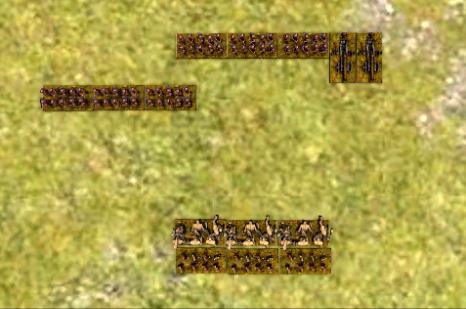
In this example the Ogres wish to charge the more distant unit of Crossbows.

The charge order is successful and the first stand is moved centre to centre against the closest visible Crossbowmen stand. This means the Ogre stand also contacts the unengaged Crossbowmen unit, and so has to slide to the left to fit centre to centre against the target. Both Crossbowmen units are now in combat, and both can stand and shoot!
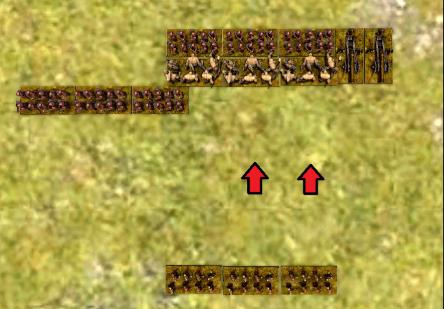
The remaining Ogre stands are now placed in a battle line. The third stand also contacts the cannon, and slides into position along the side of one cannon stand. The cannon are now also in combat (and can stand and shoot!).
→ Rulebook: Combat – Incidental contact
In what order are combats resolved? The rules don’t specify when casualties should be removed.
First, roll attacks for both sides.
Then record hits inflicted on both sides.
Then establish the winner of the combat round.
Then the loser removes casualties from their units first.
Then the winner removes casualties second.
If the combat is a draw, roll off to see who removes casualties first, then fall back.
If one side won, then once casualties are removed, work out the direction of retreat.
Then the loser retreats, and the winner decides whether to pursue, stand it’s ground, or fall back.
→ Rulebook: Combat at a Glance
The diagram under Supporting pursuits shows a victorious unit pursuing a unit that has retreated. The stand on the right of this is now contacting a unit to the front, and along its left edge. Is it being flanked in this example image?
No. Stands do not apply the enemy in flank or rear penalty to attacks for side to side contact that often occurs in pursuits. The enemy in flank or rear attack penalty only applies to stands that have the front edge of an enemy stand in their flank or rear.
→ Rulebook: Combat – Attack modifiers.
If a unit pursues an enemy that has retreated, can it wrap around to surround all edges of the enemy unit, as long as the stands remain touching? Or does it need to maximise contact to the front first?
Work out each pursuing unit’s pursuit on a stand-by-stand basis.
Basic pursuit – If a stand can pursue straight forwards so that its front edge contacts a retreating enemy stand, it must do this. Once all stands from the unit that can pursue straight forwards have done so, any remaining stands in the pursuing unit can be placed into formation as the owning player wishes, including into support, or into the flanks or rear of the retreating enemy, provided they do not exceed a full pace move.
Indirect pursuit – If there are no enemy stands directly in front of a pursuing unit’s stands, and it can draw line of sight to the retreating unit, then take any one stand from the pursuing unit that has a clear path to the retreating enemy and move it into base contact with the nearest visible retreating enemy stand, exactly as you would for a charge. Any remaining pursuing stands can then be placed as you wish in the same way as for basic pursuits.
The following diagrams show a typical combat. Units A and B are infantry in line, with A supporting B. Units C (infantry) and D (cavalry) are the charging attackers. (Due to the distance moved, unit C could not achieve maximum frontage against unit B, which allowed Unit D to fit two stands into the combat.) Units A and B are in combat with units C and D.
A and B lose the combat. B removes casualties, and the surviving stands from both units then retreat.
The stands from units C and D able to pursue straight forward into front edge contact with the enemy must do so:
Note that one stand from unit C has to contact unit A, and is therefore flank-to-flank with unit B. In the next diagram, pursuing stands that do not have to pursue straight forwards may now be placed in formation with the rest of their units, as the player wishes, including into the flank or rear where possible. No pursuing stand may move further than a full-pace move. This shows one option:
Note there is no requirement for stands that do not have to pursue straight forwards to be moved into contact with the enemy. Unit C could move a stand into support, and unit D can form up a line.
The examples continue with this arrangement.
After the second round of combat, unit B has been wiped out, and unit A has retreated again. All units have lost a stand.
Unit C pursues straight forwards again, keeping one stand in support. However unit D no longer has any enemy stands directly in front. It can still see the retreating enemy, so it can make an Indirect Pursuit.
An Indirect Pursuit requires the unit to pick one stand and align it to the retreating enemy as if for a charge, so we check to see if the cavalry are now in the front or the flank of unit A. They are in the flank.
Unit D moves one stand into contact with the flank of unit A.
Finally, the remaining stand can be placed as in basic pursuit, for example to the rear.
Combat drop outs and Advances.
Unit A charges enemy infantry unit B which is alongside enemy infantry unit C.
Unit C offers one stand to support unit B in the combat, so C is engaged.
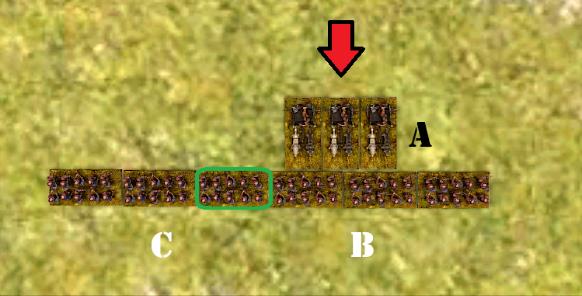
Unit A wins combat so units B and C retreat. Due to casualties, unit B is no longer in contact with unit C so there is no support, and unit C has dropped out of combat. Unit A pursues B.
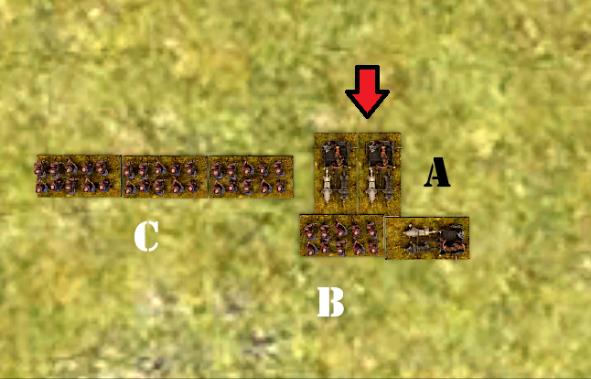
In the second round, unit A destroys unit B. It can now see unit C.
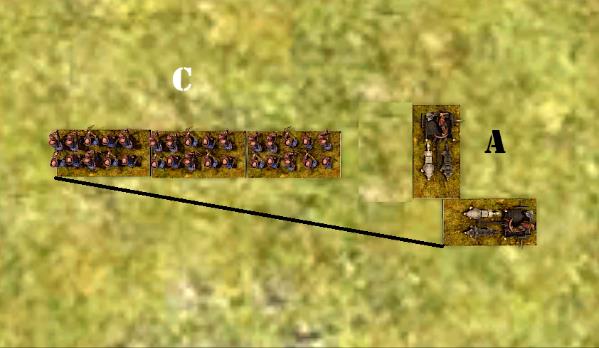
Can Unit A now advance into unit C?
No. Unit A has not destroyed all enemies in the original combat engagement. Although unit C dropped out of combat, it is a friendly unit that got separated due to the removal of stands, and therefore counts as being in the same combat engagement until the end of the combat phase. Therefore Unit A cannot advance into unit C in this scenario.
→ Rulebook: Combat – Advance.
Can a non-flying unit pursue flyers when charging into their flank or rear?
Yes, non-flying units can pursue flyers when the charging unit charged a flying unit in the flank or rear. It works in the same way as cavalry being charged into flank or rear by infantry.
→ Rulebook: Combat – Which units can pursue?.